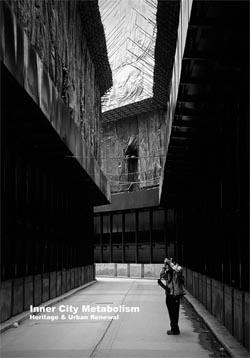Inner City Metabolism - Heritage & Urban Renewal

Students: Elisa Brusky, Matthias Baer
in collaboration with CUHK Students Lai Sun Sandy Ip, Lu Jin
Location: Group work in Hong Kong
Date: June, 2008
Type: Research project, student work, heritage & urban renewal
A common cliché of Hong Kong classifies it as is a city of frenetic rebuilding, where the old is swiftly demolished to make room for the new and where even the most recently constructed buildings are always threatened with demolition. Contrary to this expectation, an intense interest into the faiths of urban and architectural heritage became the present day ‘hot topic’ of Hong Kong; a phenomenon involving government, private parties, charity organizations and citizen groups.
A case that encapsulated the fervour of the heritage controversy in Hong Kong was the demolition of the Star Ferry Pier in November 2006, one of the most important artefacts of the colonial city and a historical point of arrival to Hong Kong. The demolition caused vehement protests by citizen groups, as well as the response of Hong Kong’s liberally minded government and its Chief Executive Donald Tsang who once again stated the underlying dilemma – that Hong Kong can not afford to preserve heritage against its economic interests.
The relevance of heritage in Hong Kong was first recognized in the 1970s, when the replacement of historic fabric with high towers began. Since 1980, 54 listed historical buildings out of 607 have been demolished. Very often these protected projects were demolished illegally or with the tolerance and acceptance of the government. Especially after the handover in 1997, heritage came more strongly into public focus as the HKSAR government continued and even intensified the liberal replacement of heritage buildings and historical areas begun in the '70s under the British. Large volume of the present built production in Hong Kong is carried out through urban renewal of older and less dense inner city areas of Honk Kong island and Kowloon (some 220 projects in Wan Chai, Yau Ma Tei, Mongkok, etc.). The pressure on such sites increases further since the decision to stop with land reclamation due to environmental consequences. The massive urban renewal projects are carried out under the governmental agency URA, Urban Renewal Authority, criticized for legitimizing private interests of property developers. Historical buildings and areas seem to be recognised by the government mostly as an opportunity for adding value and reinforcing tourist experience, so new designs appear replacing old ones with vague nostalgic looks (the case of Star Ferry Pier) - commercial projects disguised into pseudo-historic costumes.
At present, it seems that ‘battle to save urban Hong Kong is fought one building at a time’. Citizens are now taking on the practice of opposing almost every government-directed heritage-regeneration scheme, with counter proposals and extensive media coverage. We could speculate that, after the handover, heritage debate in Hong Kong has gained political undertones and became an arena where larger issues of decreasing democraticness and human rights are played out.
Download the Book PDF

